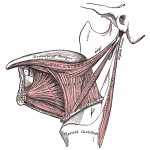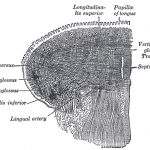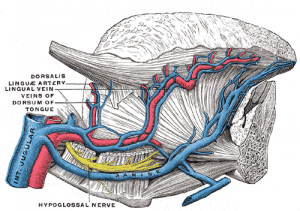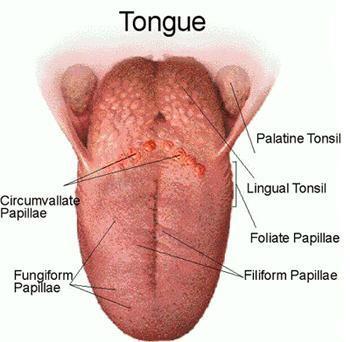
The human tongue is a muscular hydrostat (hydraulically powered food grabber in the same class as an elephant trunk, snake tongue, or octopus arms) with no support that acts as the organ for taste, or gestation. It lies the floors of the mouth of vertebrates and moves to manipulate nutrition for digestion and mastication (chewing). It maintains constant pressure and is made of three directions of muscles and blood vessels to supply nerves and blood vessels. Many cultures also use the tongue phonetically, for specific communication (whistling, growling, kissing), or for cleaning the teeth and mouth.
There is a significant amount of musculature connecting the tongue to the mouth. There are eight muscles in the tongue region, classified into intrinsic or extrinsic. The four intrinsic muscles change the shape of the tongue and are unattached to bone, while the four extrinsic muscles change the position of the tongue and are anchored to bone.

The extrinsic muscles are the hyoglossus, genioglossus, styloglossus, palatoglossus that allow the tongue to extend outwards, retract, and move side to side. The intrinsic muscles of the tongue all originate and insert within the tongue. These muscles shape the tongue by lengthening and shortening, curling and uncurling, and flattening and rounding the surface. These muscles facilitate speech, swallowing, eating, and provides for the shape of the tongue. The average length of the tongue is about 10cm.
The tongue receives blood through the lingual arteries, all of which drain into the internal jugular vein. The tongue is innervated by several nerves which carry the sensation of taste to the brain. The chorda tympani, the lingual nerve, the trigeminal nerve, and the glossopharyngeal carry the nervous information to the brain. The chorda tympani is particularly interesting, because it also innervates the muscles of the face, meaning there is likely a strong connection between facial expression and the sensation of taste and similarly, the trigeminal nerve is responsible for sensation in the face and the motor functions of biting and chewing. Together, these nerves create the highly specific feedback loop that ends up as the sensation of taste in the brain.

The tongue is covered with numerous taste buds, however, the sensations of different tastes are not localized to specific areas of the tongue. This was disproven and all taste sensations come from different parts of the tongue, though certain regions can be more sensitive to certain flavors. The different taste buds are filiform papillae, fungiform papillae, vallate papillae, and foliate papillae.
The taste receptors function by waiting for stimulus chemical to interpret, called tastants. Once a tastant has dissolved in saliva, it makes contact with the plasma membrane of the gustatory hairs, which are the site of transduction (conversion of one stimuli to integrate into the nervous system). The tongue is equipped with mostly taste buds on its dorsal (upward facing) surface, to sense the five different kinds of taste: umami, sweet, sour, bitter, and salty. Umami is currently the most researched and debated of the five kinds of taste.
Fungiform papillae, vallate papillae, and foliate papillae are the most associated with taste, while the filiform papillae is far more associated with increasing surface area of the tongue and to increase the friction between the tongue and food.
Bacteria builds up easily on the tongue and is the second most vulnerable soft tissue to pathogens, next to the gums. Tongue scraping can assist with removing debris and bacteria from the surface of the tongue. This can also be done with a brush, but I think that both are extremely useful for keeping the oral cavity clear of pathogens and potential disease. Most vertebrate animals have and use tongues, some are specifically adapted to catching prey, or to clean and groom fur, clear nostrils, or to regulate heat in the case of a dog. The tongue is an organ that has evolved over a long period of time and is extremely useful for animals that live above the sea-level.
That does it for the tongue, this will lead into the final bandha article, Jihva bandha, so check back soon to see more details about how to use the tongue while practicing. Talk to you soon!

